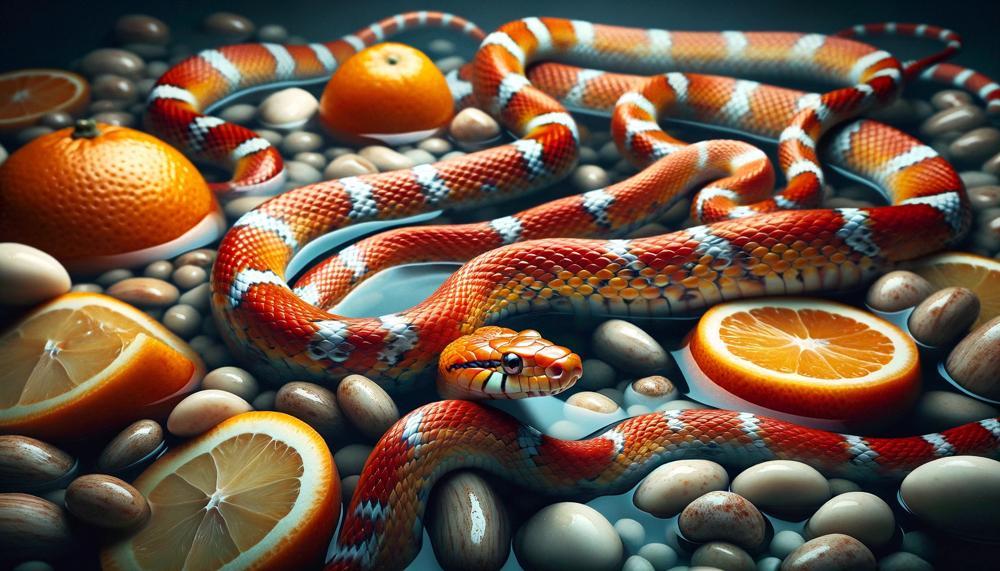Despite their slithery reputation and land-bound lives, corn snakes harbor a surprising and often overlooked skill that can redefine our understanding of these colorful creatures.
As we dive into the depths of this subject, we’ll explore the natural instincts and biological traits that enable corn snakes to navigate aquatic environments.
In this article, we’ll uncover:
- The Natural Swimming Abilities: How corn snakes are equipped to swim and what drives them into the water.
- Behavioral Patterns: Insights into when and why corn snakes might choose to take the plunge.
- Safety and Health Considerations: Understanding the benefits and potential dangers of swimming for these reptiles.
- Practical Advice for Pet Owners: Tips for managing and facilitating a corn snake’s swimming in a safe and healthy manner.
Prepare to be immersed in a detailed exploration that sheds light on the lesser-known aquatic side of corn snakes, blending scientific facts with practical insights to captivate both reptile enthusiasts and curious readers alike.
Contents
- 1 Key Takeaways
- 2 Do Corn Snakes Swim in the Wild?
- 3 Can Baby Corn Snakes Swim?
- 4 Do Corn Snakes Like to Soak?
- 5 How Long Can Corn Snakes Hold Their Breath Underwater?
- 6 How to Bathe a Corn Snake
- 7 How to Soak a Corn Snake
- 8 Is It Safe for Pet Corn Snakes to Swim?
- 9 Where Can Pet Corn Snakes Swim?
- 10 What Are the Benefits of Letting Pet Corn Snakes Swim?
- 11 Conclusion
Key Takeaways
| Aspect | Detail | Advice |
| Swimming Ability | Corn snakes can swim, using their tails for propulsion. | Provide occasional swimming opportunities. |
| Environment | Though terrestrial, they can adapt to watery habitats. | Include a shallow water area in their enclosure. |
| Health Benefits | Swimming aids in shedding and regulates body temperature. | Allow swims during shedding periods for easier peel. |
| In Captivity | Require a suitable habitat with correct conditions. | Maintain appropriate tank conditions and cleanliness. |
| Safety Measures | Monitor during swimming to prevent stress or drowning. | Never leave unattended during bath times. |
| Stress Indicators | Signs include loss of appetite and dull coloration. | Observe behavior post-swim and consult a vet if stressed. |
Corn snakes, famed for their gentle nature and vivid colours, find fans in many reptile enthusiasts. Not quite aquatic but not shy of a paddle, these critters showcase an intriguing blend of terrestrial and aquatic behaviour. Their long, lithe bodies slice through the water, though they’re naturally more at home on solid ground.
Ensuring a snug, safe, and sprightly environment is key for these slinky friends. A tank mimicking their natural digs, equipped with a spot for a splash, keeps them chipper and in fine fettle. But, it’s not all just fun and games in the water; watch them like a hawk during these swim sessions. Stress ain’t just a human thing – snakes feel the pressure too, and they’ll let you know, albeit subtly.
Regular baths – sans the bubbles and fragrance – do more than just keep them clean; they’re a boon for their health, especially when it’s time to shed the old for the new. But remember, while these swims can be beneficial, they’re not daily necessities.
Do Corn Snakes Swim in the Wild?
Indeed, corn snakes possess the knack for swimming in their natural environments. Though not habitual swimmers, they demonstrate adeptness in water when the need arises. Here’s a breakdown of their swimming capabilities and related behaviors:
| Capability | Details | Context |
| Swimming Ability | Can use tails for propulsion | Swimming is an occasional activity |
| Benefits | Exercise, muscle strengthening | Also aids in shedding |
| Behavior | Excellent climbers, may exit water if scared | Prefer dry land but can adapt to water |
| Environmental Preference | Fields, meadows, forests, barns | Water bodies are not primary habitat |
Corn snakes, with their vibrant hues and mild manners, are a hit amongst reptile enthusiasts. Understanding their swimming capabilities enhances our grasp of their behavior and needs, both in the wild and in captivity.
Can Baby Corn Snakes Swim?
Yes, baby corn snakes can swim. These wee reptiles, akin to their adult counterparts, possess the innate ability to navigate water. This skill, right from their early days, is not just about survival but a testament to their adaptability.
As they grow, their swimming prowess only sharpens, bolstered by increased muscle strength and confidence.
Swimming Capacity of Baby Corn Snakes: A Deep Dive
| Age | Swimming Ability | Notes |
| Newborn | Capable | Instinctual swimming skills, but prefer shallow water. |
| 1-3 months | Improving | Greater confidence, can navigate deeper waters. |
| 3-6 months | Advanced | Strong muscle development supports longer swimming sessions. |
Starting life with a penchant for damp nooks and crannies, baby corn snakes showcase a remarkable capacity for swimming. Initially, these slithering infants might seem hesitant, dipping into the shallows with a mix of curiosity and caution. Yet, it’s in these moments that their aquatic acumen begins to take root.
As weeks turn to months, their affinity for aqua adventures grows. What starts as tentative paddling in the paddling pool of their youth soon blossoms into confident cruising in deeper domains. Their slender bodies, engineered by nature for graceful gliding, slice through the water with ease—a sight to behold.
It’s essential, though, to underscore the balance required in their habitats. While a splash and a swim can do wonders for their well-being, ensuring they have dry land to return to is paramount. After all, much like us, they crave the comfort of a solid ground underfoot after a dip.
Caring for these fascinating creatures calls for an understanding of their needs—both terrestrial and aquatic. Providing them with opportunities to swim in a safe, controlled environment can aid in their development, not just physically but mentally too, enriching their lives in captivity.
Do Corn Snakes Like to Soak?
Yes, corn snakes do take pleasure in soaking. This behavior is not merely a whimsy but has tangible benefits for their health and well-being. They immerse themselves in water for several reasons, primarily to ease the shedding of their skin and to rid themselves of parasites.
Reasons for Soaking:
- Shedding Assistance: The act of soaking helps soften and loosen their old skin, making the shedding process smoother and less stressful for the snake.
- Parasite Relief: Soaking can help eliminate unwelcome guests such as ticks and mites, ensuring the snake remains healthy and comfortable.
How Long Should They Soak?
It’s advisable for corn snakes to spend a certain duration in a warm water bath. The table below illustrates an optimal soaking schedule:
| Duration | Frequency | Purpose |
| 15-20 minutes | Once per week or during shedding | Assist in shedding and hygiene |
| 10-15 minutes | If infested with mites/ticks | Parasite removal |
How Long Can Corn Snakes Hold Their Breath Underwater?
Corn snakes can maintain their underwater composure, typically holding their breath for a few minutes, although the exact duration can vary based on individual health, stress levels, and environmental conditions.
These reptiles are equipped with physical and behavioral adaptations that enable this capability, ensuring their survival and well-being in their aquatic endeavors.
Adaptations and Considerations:
- Ectothermic Regulation: As ectotherms, corn snakes regulate their body temperature externally. This trait minimizes their oxygen requirements when submerged, allowing them to stay underwater longer.
- Efficient Lung Capacity: They possess a lung structure that is efficient in oxygen absorption, maximizing the utility of the air they inhale before diving.
- Behavioral Instincts: Instinctively understanding the limits of their breath-holding capacity, they are adept at determining when to resurface for air.
Practical Bathing Insights:
| Aspect | Detail | Relevance |
| Soaking Duration | Up to 15 minutes | Ensures hydration, aids in shedding, and removes parasites. |
| Water Temperature | 80-85°F (26.7-29.4°C) | Optimal for preventing cold stress and encouraging natural behavior. |
| Bathing Benefits | Hydration, Shedding Aid | Supports skin health and overall wellbeing. |
It’s essential to tailor the soaking experience to each snake, observing their behavior and preferences, ensuring they’re comfortable and safe during their aquatic moments.
While they can hold their breath for a considerable time, it’s crucial to avoid prolonged submersion to prevent stress or potential drowning hazards.
How to Bathe a Corn Snake
Bathing a corn snake is not only safe, but it’s also beneficial for their health, provided it’s done correctly. Here’s how to ensure a safe and enjoyable bath for your corn snake, keeping in mind their natural behavior and physiological needs:
Preparing the Bath
Water Temperature
Ensure the water is warm, ideally between 80-85°F (27-29°C), to prevent chilling or overheating the snake.
Water Quality
Use clean, filtered water to avoid exposing your snake to harmful chemicals or contaminants.
Bathing Duration
Keep the bath time to about 10-15 minutes to prevent stress and maintain the snake’s body temperature.
Bathing Process
| Step | Action | Notes |
| 1 | Gently place the snake in the bath. | Ensure the water is shallow enough for the snake to easily lift its head out of the water. |
| 2 | Allow soaking. | Snakes may submerge themselves; they can hold their breath for minutes at a time. |
| 3 | Supervise the bath. | Stay with your snake to monitor its comfort and safety. |
| 4 | Gently dry the snake. | Use a soft towel to pat the snake dry, avoiding any cold drafts. |
Health Benefits
- Aids Shedding: Helps in removing old skin efficiently.
- Skin Care: Softens the skin, removing any infestations or debris.
- Hydration: Encourages hydration, especially if the snake is not drinking enough.
Enclosure Considerations
- Always provide a shallow bowl of water in the snake’s enclosure for soaking, ensuring it is clean and the water is changed regularly.
- Monitor for signs of stress or discomfort post-bath, including changes in appetite or behavior.
How to Soak a Corn Snake
Soaking a corn snake is not just a mere routine; it’s a vital part of their care, enhancing their well-being and assisting in their natural processes.
Why Soak a Corn Snake?
- Aid in Shedding: Helps remove old skin effortlessly.
- Relaxation: Provides a serene retreat.
- Hydration: Ensures they stay hydrated.
- Cleanliness: Keeps their skin pristine and lowers the risk of skin issues.
How to Soak Your Corn Snake – Step by Step
| Preparation | Arrange a heavy, shallow dish. It should be ample for the snake to lounge in entirely. | Ensure the dish is stable to prevent tipping. |
| Water Conditions | Fill with clean, lukewarm water, not too deep to avoid distress. | The temperature should mimic their enclosure’s warmth, avoiding extremes. |
| Soaking Time | Allow your snake to soak for 15-20 minutes, but never unsupervised. | Watch for signs of stress or discomfort. |
| Post-Soak Care | Gently lift the snake from the bath and pat dry with a soft towel. | Return to its habitat ensuring it’s warm and cosy. |
| Safety Tips | Avoid direct sunlight, especially for albino types. | Never leave your snake unattended in the water. |
Remember, while soaking is beneficial, it should not be overdone. Once every few weeks is adequate unless shedding issues occur. Observing your corn snake’s behavior and health signs is paramount; consult a vet if unusual signs persist.
They adore water, but respect their limits, keeping each soak brief and serene. Always reintroduce them to their home gently, letting them slither back to comfort at their own pace.
Is It Safe for Pet Corn Snakes to Swim?
Yes, it is generally safe for pet corn snakes to swim under the right conditions.
However, there are several potential risks and guidelines to consider ensuring the safety and comfort of your snake during its swim.
Potential Risks and Precautions:
| Risks | Details | Precautions |
| Temperature Extremes | Excessive cold or heat can distress or harm your corn snake. | Maintain water temperature between 80-85°F. |
| Drowning | Though unlikely, there is a risk if the snake cannot reach a safe area easily. | Use shallow bowls or tubs and always supervise. |
| Stress | Forced swimming can cause anxiety or stress in corn snakes. | Never force your snake to swim and observe its behavior closely. |
Guidelines for Safe Swimming:
- Monitor Water Temperature: Keep the water within the safe range of 80-85°F to avoid thermal shock or stress.
- Supervise: Always keep an eye on your snake while it is in the water to prevent any accidents or distress.
- Shallow Water: Opt for shallow containers that allow the snake to easily touch the bottom and lift its head out of the water.
- Acclimation: Allow your snake to gradually acclimate to the water rather than placing it directly into deep or cold water.
- Post-Swim Care: After swimming, gently dry your snake with a soft towel to remove excess moisture and return it to its enclosure to rest.
Remember, while swimming can provide benefits like exercise and aid in shedding, it’s not a necessity for every corn snake.

Where Can Pet Corn Snakes Swim?
Pet corn snakes can indeed enjoy a paddle in the water, provided their human pals ensure the environment is just right for them.
Here’s how to make sure your slithery friend has a safe splash.
Safe Swimming Spots for Pet Corn Snakes:
| Environment | Description | Considerations |
| Shallow water dish | A dish inside their enclosure with shallow water allows for easy and safe access. | Keep the water clean and at room temperature to prevent chilling. |
| Bathtub or sink | A controlled, shallow water environment under supervision. | Ensure water is lukewarm and there’s no way for the snake to escape or get injured. |
| Special reptile pools | Small, shallow pools designed for reptile use can be placed inside or outside the enclosure. | Monitor the snake at all times and maintain the water at a suitable temperature. |
Corn snakes, not being aquatic by nature, appreciate the occasional swim not as a lifestyle but as a delightful diversion, offering them exercise and aiding in shedding. However, their habitats must be kitted out with care:
- Water Temperature: Crucial for their comfort, the water should feel like a tepid embrace, not too hot, not too cold.
- Supervision: Like toddlers at the pool, corn snakes need an eye kept on them to prevent any mishap.
- Duration: Short and sweet; their time in water should be brief to avoid stress or cooling.
- Aftercare: Post-swim, ensure they’re dried off gently to ward off the chills.
With these measures in place, your corn snake can have occasional aquatic adventures safely.
What Are the Benefits of Letting Pet Corn Snakes Swim?
The act of letting pet corn snakes take a dip in the water comes with a bundle of benefits, enhancing their health and influencing their behaviour in positive ways. Here’s a breakdown:
Health Benefits:
- Skin Care and Shedding: The water softens their skin, making the shedding process smoother. It’s akin to a spa treatment, offering relief and aiding in the removal of old skin with less fuss.
- Temperature Regulation: As creatures that rely on their environment to manage body temperature, a swim can help cool them down, particularly after basking or in warmer climates.
- Hydration: A swim isn’t just about exercise; it’s also a chance for these reptiles to absorb some moisture, keeping their skin supple and preventing dehydration.
Behavioural Benefits:
- Stress Relief: Just like a good swim can soothe human nerves, it can also reduce stress in corn snakes, leading to a happier, more content pet.
- Exercise: Swimming provides a form of physical activity that’s both enjoyable and necessary for their health, helping prevent obesity and related health issues.
Here’s a quick table summarising these benefits:
| Aspect | Benefit | Impact |
| Skin and Shedding | Softens skin, aids shedding | Healthier skin, easier shedding process |
| Temperature Regulation | Helps cool down | Prevents overheating, improves comfort |
| Hydration | Moisturizes skin, promotes hydration | Prevents dehydration, improves skin health |
| Stress Relief | Reduces stress levels | Leads to a calmer, more relaxed snake |
| Exercise | Provides physical activity | Helps maintain healthy weight, reduces boredom |
By providing a shallow pool for your corn snake to explore and swim in, you’re not just catering to their physical needs but also enriching their living environment. This, in turn, can lead to a more vibrant, active, and healthier pet.
Conclusion
Diving into the aquatic adventures of corn snakes uncovers a world where these terrestrial beings elegantly morph into graceful swimmers, revealing an often-unseen facet of their existence.
Far from being mere land dwellers, corn snakes possess an innate ability to navigate the water, using their tails for propulsion and showcasing an adaptability that surprises many. This skill is not only a testament to their versatility but also serves practical purposes, aiding in shedding, offering a means of exercise, and providing a method for temperature regulation.
For pet owners, understanding and facilitating this aspect of corn snake care can lead to healthier, happier snakes, highlighting the importance of creating a habitat that allows for occasional swims. Equipped with shallow water areas, monitored for safety, and balanced with dry land, a corn snake’s enclosure can become a haven that nurtures both their terrestrial and aquatic inclinations.
From the enthusiastic paddles of the youngest snakes to the composed swims of the adults, these reptiles demonstrate a remarkable capacity for adaptation, embodying the essence of resilience and versatility.






